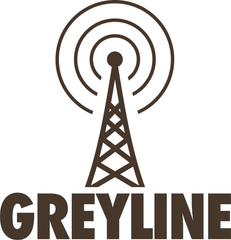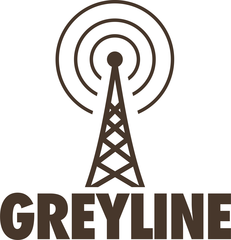
For Greyline OCF Vertical Dipoles and Flagpole Antennas
You've received your Greyline antenna box (and possibly a second box containing the Feed Kit) in the mail and you are now preparing for the install.
As always we ask that you inspect the parts to be sure you have all the parts and proper tools needed for the project. Also it is wise to familiarize yourself with the arrangement order of things...
How to Correctly Configure the DX Flagpole, Diagram here:
https://greylineperformance.com/blogs/news/correctly-configuring-the-flagpole-tuner-and-balun-feed-system
Feed Kit Installation
Included you'll find:
- Ladder-line
- RF Choking (Mix 31 Snap on Ferrite Beads)
- Adapter Kit (LL to PL 259)
- Mini or Maxi Choke (many choose to add one or more of these to the order)
Layout the feed line:
You'll want to have your antenna disassembled from the upper to lower insulators. To start on the ladder line project, take your ladder line and lay it along side the lower dipole section, between the two insulators, in position. You'll have extra length, of course, and most of this will end up extra out the lower insulator when we are finished.
Upper Insulator, aka Feed-point:
You'll see the upper insulator has two holes. For ease of description one is left, the other is right. Cut down the center of the first plastic block (or ladder) and clean up the plastic around the wires so they each can fit through each hole, left and right. Leave 2-3" of extra length so that you can attach these wires to the upper and lower pole sections by way of the first screw-bolt on each pole. You'll want to strip away 1-inch or so of wire insulation so the bare wire can be used to feed the power when the time to fire up the radio arrives.
Spacers: 3-4 provided
Now that you have measured the extra wire for the upper insulator you can also now gauge where you will install the Spacers provided. These are meant to keep the ladder line away from the tubing walls, internally within the lower dipole. These can be slipped over the ladder line (in the curved space available on each) and positioned approximately every 1 1/2 feet. This keeps the feed line centered until it reaches the insulators on both ends.
Bottom Insulator, one slot hole:
You should have 2-3 feet of excess ladder line at this bottom end. The lower insulator is meant to be just above ground level. Push the line through the slot and out. The antenna can be inserted into the ground sleeve at this point, if you like.
Connecting the Ladder line to the 3D Adapter Kit
Many of you will use the Adapter Kit provided. This is a handy 3D printed set of pieces that will allow your ladder line to connect to the universally known and loved, PL 259. (Coaxial Cable connector).
Step-by-Step: How to build this adapter, here:
https://greylineperformance.com/blogs/news/greyline-dx-ladder-line-to-coax-pl-259-adapter
Pro Tip: Mark both ends of one side of the ladder line's two wires. You'll want to be sure you connect the top longer radiating pole to the center conductor of your coax, in the end. You'll be 25-35 dB louder. That's important, right?
Alternative to the Adapter Kit:
Ladder-line to PL259 RF Chokes (Mini + Maxi) are now available in our Add-On section.
Not all of us were Boy Scouts and some of us just don't want to buy a soldering iron and deal with the mess. That said, some of us do, and that's okay, right? Let's face it, plug and play is here to stay for so many of us and for you, we have the easy solution, and it's Military grade too. We are now having made for us, RF Chokes that receive the ladder line directly out of the bottom of the vertical antenna connecting to the RF Choke directly, no adapters, no extras, just pushing the wire into two simple spin-nuts with easy to follow color coding (red and black) so you know exactly where to connect the UPPER longer pole wire from your ladder line. (Hint: To the Red spin nut).
RF Chokes (Standard and LL versions) can be found here: (add one to your cart)
https://greylineperformance.com/collections/rf-choke-1-1-current-balun-cmc-common-mode-choke
Question? We are finding with high quality choking, you can place the RF Choke between the antenna and the remote tuner. This is fine. A bonus occurred as well. In this scenario, one can ground the tuner, most tuners. If one tried to ground the tuner between the RF Choke and the Antenna, the remote tuner would act up, try tuning every time one touched the dial. That can be annoying. Don't do that. Swap the positions of the RF Choke and the Tuner and you should be solid and symptom free once again.
Summary:
There are many ways to feed your antenna system. By default we send out a 3D printed set of parts that take the ladder line and transform it into a PL-259 coax connector. To avoid extra parts and adapters consider the RF Choke Mini (500W) or Maxi (3500W). They are super high quality and make life easier if there is CMC (common mode current) occurances along your coaxial cable. Longer coax runs have been known to attract the CMC.
On that note, to mitigate QRN which might be picked up along the longer coax runs back to the radio, you might consider installing a Mini choke just behind the radio or a Maxi just behind the amplifier if you run higher power. This could cut some noise making signals seems louder and in some cases could make the difference in hearing a signal and not hearing them at all. Pretty neat, right?
Did you learn something here? This is an adventure for us and we hope the same for you. What DX will you work this year?
Remember, Ham Radio is Fun Again!
It's a pleasure to serve you with Strong, Smart, and Elegant Antenna systems.
73 Greyline Performance

